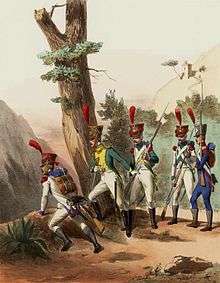Irish Legion
Napoleon's Irish Legion (French: Légion irlandaise) was a French light infantry battalion established in 1803 for an anticipated invasion of Ireland. It was later expanded to a four battalion regiment with a depot and won distinction in the Walcheren Expedition and the Peninsular War. It was disbanded in 1815.
Establishment
The first officers included Irish rebels taken during the 1798 rebellion who were freed during the short peace effected by the Treaty of Amiens on condition of exile, and who had sailed for France in June 1802. The treaty broke down in May 1803 with the start of the War of the Third Coalition. As a part of Napoleon's planned invasion of the United Kingdom in 1803-05, the Irish Legion was to provide the indigenous core for a much larger invasion force of 20,000 earmarked to take Ireland, known as the Corps d'Irlande.
The Legion was established on August 31, 1803[1] in Morlaix, France.[2] Bernard MacSheehy was assigned to form the regiment he was an Adjutant-General in Napoleon's army.[3]
The purpose of the Legion was to align the Irish hearts to the French cause in the imminent invasion of Ireland.[1] General Pierre Augereau had been ordained to lead the invasion, and wanted Irishmen to serve in his army.[2] However, the Battle of Cape Finisterre and the Battle of Trafalgar in 1805 made a safe sea crossing uncertain at best, and Napoleon was forced to abandon his plans for Ireland. He shifted his focus towards Austria and Eastern Europe and launched the Austerlitz campaign in late 1805.[2] The legion remained on the French coast on garrison duty and coastal defence.
Formation and colors
The Legion was eventually expanded from a battalion to a regiment and there was greater demand for more soldiers.[1] These made a varied group; some came from Ireland, some had been pressed into the Royal Navy and escaped, and some were German or Polish.[1] While the Legion was stationed at Mainz in 1806, they were joined by 1,500 Poles [2] together with around 200 former United Irishmen who had been sold by the British Government following the recent Irish risings to Prussia to labour in her salt mines and had later joined the Prussian army. Its headquarters was at 's-Hertogenbosch, known to the French as Bois-le-Duc, in what was then the Kingdom of Holland.
The Irish Legion had its own flag, and in December 1805 received an eagle.[2] The Legion was the only group of foreign soldiers in the French military to whom Napoleon ever gave an eagle.[3] Wearing a green uniform,[2][4] its maximum size was about 2,000 men.

The regiment was greatly assisted from 1807 by Napoleon's war minister Marshal of France Henri Clarke, who was born in France to Irish parents and whose family had close links to the ancien regime Irish brigade of France. He and his father had served in Dillon's Regiment, and his mother's father and several uncles served in Clare's Regiment.[5] In August 1811 the Legion was renamed the 3e Regiment Etranger (Irlandais) (3rd Foreign Regiment (Irish)), but throughout the unit's history it was always referred to as the Irish Regiment.
Actions
In 1808 the Second Battalion fought in the Peninsular War, helping to subdue Madrid during the Dos de Mayo Uprising and winning distinction at the Siege of Astorga, leading the charge that took the city.[2] During the battle, Captain John Allen's company's drummer boy continued to beat the charge after having lost both legs, for which he was given the French Legion of Honor.[1] In June 1810 it was reassigned to Masséna's Army of Portugal and served in Almeida and in the Battle of Fuentes de Oñoro in 1811.
The First Battalion saw its first action at the Battle of Flushing in the Walcheren Campaign of 1809, suffering many casualties from malaria.[1]
The Legion / regiment was a part of General Puthod's 17th division in the German Campaign of 1813. At Goldsberg the regiment formed squares to repel a cavalry attack and were then easy targets for cannon fire, losing 400 men. In a skirmish near and during the second battle of bober, Puthod's men were caught by the Imperial Russian Army with their backs to the river Bóbr in flood, but held position until their ammunition ran out, and then tried to swim to safety. The regiment suffered heavy casualties from the subsequent bayonet assault, from drownings and from pursuit by roaming Cossack patrols, losing about 1,500 men. The survivors managed to save their eagle and retired to Bois-le-Duc.
In the ensuing Napoleonic retreat the regiment took part in the Siege of Antwerp 1814 and retired to Lille, where it remained until Napoleon's abdication in April 1814. [6]
In 1805-15 eleven of the regiment's officers were awarded the Legion d'honneur, including the colonel, William Lawless, and James Bartholomew Blackwell.[7]
Disbandment
The regiment divided in loyalty during the "Hundred Days", and was officially disbanded by King Louis XVIII on 28 September 1815.[1] Its flags were burned and its eagle destroyed.[1]
Further reading
Miles Byrne, Memoirs of Miles Byrne Vol 2 (1863) and Stephen McGarry, Irish Brigades Abroad (2013).
References
- 1 2 3 4 5 6 7 8 Medlen, Virginia (2007), Napoleon's Irish Legion: La Legion Irlandaise 1803 - 1815, The Napoleonic Historical Society, retrieved 2009-10-13
- 1 2 3 4 5 6 7 Forde, Frank, Napoleon’s Irish Legion (PDF), Napoleonic Association, retrieved 2009-10-13
- 1 2 Mitchel, John (1869), The History of Ireland, 2, Glasgow: Cameron & Ferguson, p. 265
- ↑ http://legionirlandaise.forumactif.ca/forum Légion Irlandaise
- ↑ McGarry, Stephen (2013), Irish Brigades Abroad, The History Press, Dublin
- ↑ http://www.theirishstory.com/2014/03/08/from limerick to antwerp irish brigades abroad 1690-1815/
- ↑ http://www.clarelibrary.ie/eolas/coclare/people/james_bartholomew_blackwell.htm Notes on Blackwell